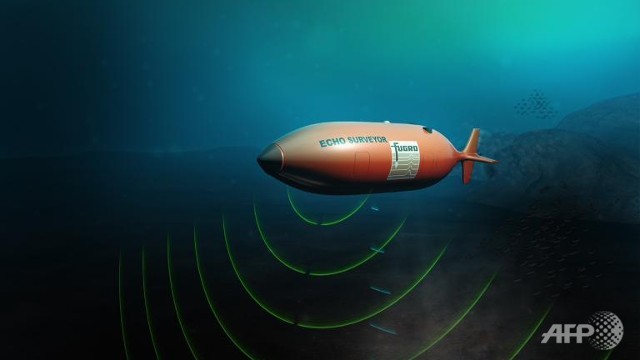Australia shifts MH370 search zone further south
 Illustration shows a Fugro autonomous underwater vehicle (AUV) launched from the Australian ship M/V Fugro Discovery as part of a new search for missing flight MH370. (AFP/Fugro)
Illustration shows a Fugro autonomous underwater vehicle (AUV) launched from the Australian ship M/V Fugro Discovery as part of a new search for missing flight MH370. (AFP/Fugro)
SYDNEY: Investigators Wednesday (Oct 8) confirmed that the priority search area for missing Malaysia Airlines flight MH370 has moved further south as end-of-flight scenarios indicated it may have spiralled into the Indian Ocean.
Seven months after the Boeing jet disappeared with 239 people onboard, the Australian Transport Safety Bureau, leading the hunt for the jet, said ongoing analysis had helped refine the zone where an underwater search began this week.
"The latest analyses indicates that the underwater search should be prioritised further south within the wide search area for the next phase of the search," it said.
Despite an extensive hunt for the plane, which was en route from Kuala Lumpur to Beijing when it mysteriously turned southwards on Mar 8, no sign of it has been found.
Aviation experts had little to go on besides the satellite communications from the plane, information they have used to pinpoint a search area in the vast ocean off western Australia.
They believe the best hope of finding the plane is within the seventh arc, or the final satellite "handshake" from the plane, estimated to be when it was in descent. The ATSB said Wednesday that when all elements of the analysis so far were taken into account, it indicated that the aircraft "may be located within relatively close proximity to the arc", although further south than initially thought.
An ATSB report in June had put the priority search zone above an underwater feature named Broken Ridge, more than 2,000 kilometres west of Perth. But the new analysis puts it south of this feature, confirming earlier suggestions.
Analysis of the satellite data and end-of-flight simulations was ongoing, and this work could result in further changes to where the search was conducted, the ATSB added.
"The simulator activities involved fuel exhaustion of the right engine followed by flameout of the left engine with no control inputs," it said in an update on the flight path analysis. "This scenario resulted in the aircraft entering a descending spiralling low bank angle left turn and the aircraft entering the water in a relatively short distance after the last engine flameout."
The analysis of communications and flight data has been used to determine the first underwater areas to be scoured, with the first ship starting its scan of the ocean depths this week.
The Malaysia contracted GO Phoenix is using sophisticated sonar technology experts hope will detect large pieces of debris such as an engines or fuselage. It will be joined by two other ships in the weeks ahead.
What the stars mean:
★ Poor ★ ★ Promising ★★★ Good ★★★★ Very good ★★★★★ Exceptional
Latest News
More News
- Thailand seeks to promote digital training (November 04, 2024 | 16:14)
- Indonesia attracts foreign investment in technology sector (November 04, 2024 | 16:08)
- Tropical storm Trami leaves at least 24 people dead in Philippines (October 24, 2024 | 17:36)
- Singapore grants conditional approval for solar power import from Australia (October 24, 2024 | 17:27)
- ASEAN digital economy set to reach $2 trillion by 2030 (October 22, 2024 | 15:08)
- Thailand asks Laos to waive visa fee at border checkpoints to boost tourism (October 21, 2024 | 17:23)
- Laos pledges to continue efforts to empower girls (October 21, 2024 | 17:17)
- Chinese electric vehicle maker to build plant in Indonesia (October 21, 2024 | 17:12)
- Vietnam Elevator Association introduces Elevator Safety Application to the world (October 18, 2024 | 09:00)
- A taste of the future - the go-to spot at the Worldchefs Congress & Expo 2024 (October 15, 2024 | 16:11)



















 Mobile Version
Mobile Version